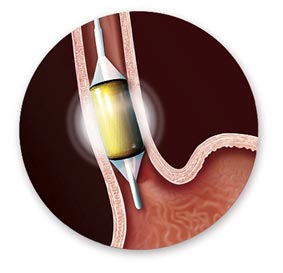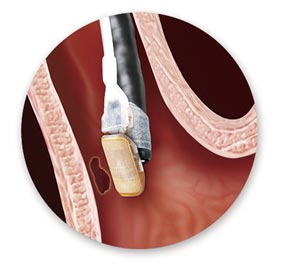Barrett’s Esophagus is a precancerous stage that affects the tissue lining of the esophagus, the tube that carries food and liquid from the mouth to the stomach.
Gastroesophageal reflux disease (ERGE) is a disorder where the stomach acid and enzymes cause lesions in the lining of the esophagus and generate symptoms such as heartburn, regurgitation and chest pain. In some patients the normal esophagus cells are damaged, and over the time this damage can cause an inflammation and genetic changes that provoke on a cell alteration. The tissue changes its appearance and also microscopically (“intestinal metaplasia” or Barrett’s esophagus).
If a patient suffers from ERGE symptoms more than 3 times per week, he should see his doctor about it. Approximately 13% of patients with ERGE also have Barrett’s esophagus.
It can only be diagnosed with an upper endoscopy and it requires a biopsy of the area where the esophagus is shows inflammation. The finding of intestinal cells in the esophagus (intestinal metaplasia) confirms the diagnosis of Barrett’s esophagus.
Different degrees of Barrett: intestinal metaplasia, low-grade dysplasia (this is the beginning of cancer), high-grade dysplasia and esophageal cancer.
The joint recommendations of medical societies indicate performing upper endoscopies with biopsy on patients with Barrett’s esophagus, regularly and for life.The frequency will be much higher in patients with dysplasia due to the increased risk of developing cancer.
In addition to the approaches through endoscopic observation for Barrett’s esophagus, there are treatment options that include endoscopic and surgical therapy to completely remove the Barrett’s tissue.
One of the endoscopic treatment options is the radiofrequency ablation or HALO. This is a technique in which the tissue is heated until it is no longer viable or alive, by delivering heat energy in a precise and controlled manner. The ablation technology HALO achieves the total elimination of the diseased lining tissue without causing any damage to the normal structures nearby.
This treatment is done in conjunction with upper endoscopy and it does not need hospitalization nor does it involve incisions. There are two kinds of ablation catheters:
HALO 360º and HALO 90º
After the procedure patients may experience chest discomfort and difficulty swallowing for several days, being treated with medication.



A.- Image with Barrett’s esophagus.
B.- Ablation with HALO 360
C.- Tissue immediately after treatment with HALO 360
Specialist in Gastroenterology
October 5, 2016
Read other news
Tel.: +34 952 908 628
+34 609 148 799
952908898 Oncology
951829978 Diagnosis by imaging
951829947 Gynecology
952908897 Fertility
951829947 Physiotherapy